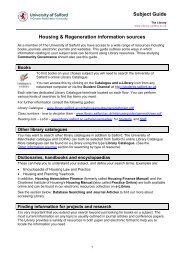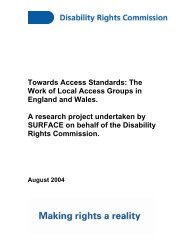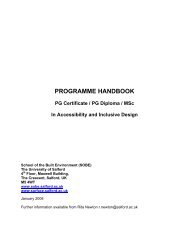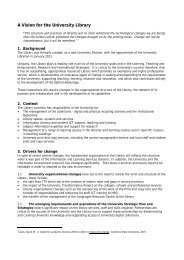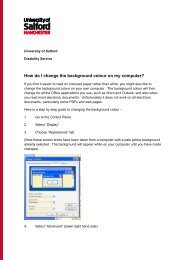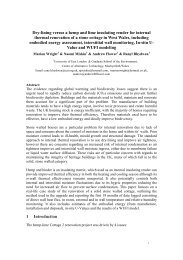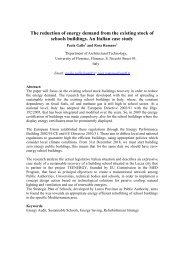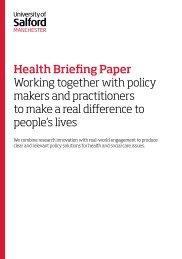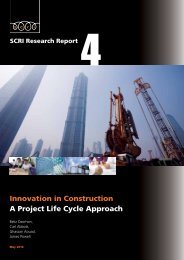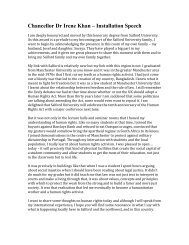Download a copy (pdf) - University of Salford
Download a copy (pdf) - University of Salford
Download a copy (pdf) - University of Salford
You also want an ePaper? Increase the reach of your titles
YUMPU automatically turns print PDFs into web optimized ePapers that Google loves.
PerspectivesPr<strong>of</strong>ileSolving the right problemsPr<strong>of</strong>essor Nigel Mellors is the newly-appointed Pro-Vice-Chancellor<strong>of</strong> Enterprise at <strong>Salford</strong>, but he has a long history with the<strong>University</strong> and in business, which dates back to even before hisundergraduate student days…Why did you choose <strong>Salford</strong> asa student?I began my career as an entrepreneurdeveloping my first enterprise venturefrom leaving high school, which I sold 10years later and took the opportunity tostudy at <strong>University</strong>. I visited several placesand considered my choice carefully beforedeciding to come to <strong>Salford</strong> for aphysics degree.What is your research about?I started out looking at nano-transmittersand the “Joule effect”– it was fascinating tobe studying what James Joule posited righthere at <strong>Salford</strong>, 150 years later. I’m currentlyvery interested in energy reduction and howto reduce the amount <strong>of</strong> waste. It’s a topicalissue and one which affects everyone on theplanet. Did you know we lose 2 kilowatts(kw) <strong>of</strong> energy for each kw used – so if yourkettle uses 3kw, it actually costs the system9kw because it takes 3kw <strong>of</strong> wasted energyto produce each kw used? We don’t needmore power if we can address this energyloss.When I started work in this area I thought itwas all about the technologies and improvingthose, but actually there is much more toconsider in terms <strong>of</strong> people’s behaviourand behaviour change . In effect, it’s theconnection between technology and peoplewhich matters – houses themselves don’t useenergy, people do.How does a business know where tostart in terms <strong>of</strong> working with the<strong>University</strong>?It could feel like searching for a needle in ahaystack trying to find out who out <strong>of</strong> our800-strong academics would be the rightperson to approach. So we’re building agateway into the <strong>University</strong> and a responsiveteam behind that. It has to be a two-waypartnership between business and researchers– even “pure” research funding agencies areinterested in the impact research can haveand how technologies can be exploited andcommercialised for everyone’s benefit.We are keen to develop long termrelationships with key partners andstakeholder both at regional and nationallevel and a more integrated approach <strong>of</strong>both research and enterprise. I believe thisapproach will lead to a more meaningfullyand sustainable relationship for both theuniversity and our partners. We have anumber <strong>of</strong> great cases studies where thishas worked extremely well including thepartnership with Greater Manchester FireService where a number <strong>of</strong> academicsfrom across the <strong>University</strong> are engaged indeveloping and supporting the Fire Servicesgoals (see page 24).Tell me more about Energy HouseEnergy House is a unique facility for peopleto easily see how research and business cometogether and get industry in to the <strong>University</strong>.Right now some <strong>of</strong> the projects we haveunderway look at thin materials to insulatebuildings, particularly retr<strong>of</strong>itting old stoneor listed buildings with easily installed energysaving measures including double-glazing ornew external cladding and internal insulationsbecause <strong>of</strong> space restrictions or aesthetics.There are many disciplines needed to developnew technologies including nanotechnology,physics, engineering, the built environmentand architecture, but we need to also includeNigel Mellors outside the Energy Houseend users and installers. If these technologiesare not installed correctly then they can work10-20% less efficiently than predicted whichhas a significant impact when the UK has 26million houses to make more energy efficientwithin this decade if it is to meet its carbonreduction commitments.What’s your vision for the future <strong>of</strong>enterprise at the <strong>University</strong>?I want the <strong>University</strong> to be a place businesscan connect with academics and real-worldresearch. To do this we need to understandacademics’ needs as well as what industryneeds. It should be a place where public,commercial, and contract research fundingcome together as the model for goingforward. We need to make sure all partiesunderstand their shared goals and howthey’re going to achieve them. <strong>Salford</strong> isin a really good position to capitalise on itsheritage in terms <strong>of</strong> real world research.We have a long history <strong>of</strong> connecting industryand public sector, and have been doing thisfor over 50 years. As a <strong>University</strong>, we’re verygood at solving problems, but we need towork with business to ensure we’re solvingthe right problems.To find out more about Energy House andsome <strong>of</strong> our consultancy work with industry,visit: www.salford.ac.uk/energy14 | May 2013



